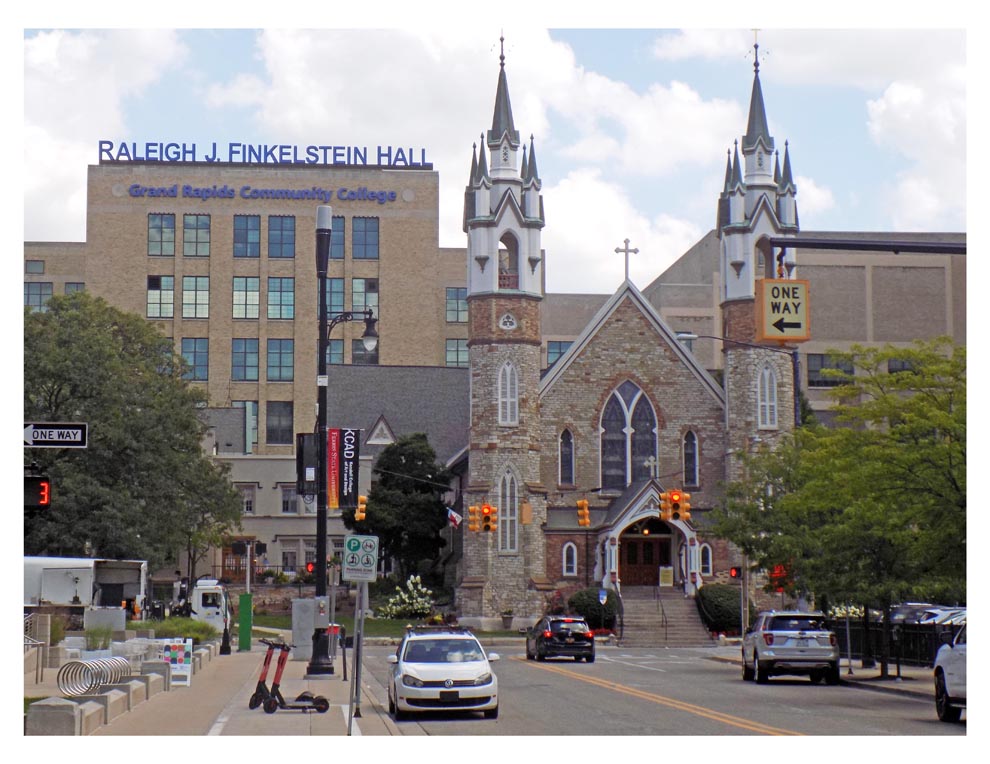

Indigenous peoples for thousands of years occupied the Grand River Valley.
By the late 1600s the Ottawa occupied territory around the Great Lakes and spoke one of the numerous Algonquian languages. They founded several villages along the Grand River.
The Ottawa called the river far-away-water due to the river’s length. There they “raised corn, melons, pumpkins and beans.” They ate game from the woods and fish from the water.
After the French established territories in Michigan, Jesuit missionaries and traders generally lived in peace among the Ottawa tribes and traded European metal and textile goods for fur pelts. One of the first European-American settlers in the Grand Rapids area was Isaac McCoy. In 1824 a log cabin and a log schoolhouse was built by a Baptist missionary the Rev. L. Slater.
By 1834-1835, the settlement population was 50 residents, including its first doctor, Dr. Wilson. The first newspaper, The Grand River Times, was printed April 18, 1837 and described the Village’s attributes, stating that “Though young in its improvements, the site of this village has long been known and esteemed for its natural advantages. It was here that Indian traders long since made their great depot.”
That article continued saying that the Village had grown from a few French families to 1,200 residents. The Grand River was one of the most important and delightful to be found in the country.
Grand Rapids was incorporated April 2, 1850 with a population of 1,510 within an area of four square miles. Swedes immigrated to Grand Rapids to create a colony arriving in October 1870. Today, a population of more than 200,000 is in Grand Rapids, a prosperous and thriving city. It was here I went last Autumn before Winter to visit the many libraries. There are 27 libraries in Kent County, and seven branched in Grand Rapids.
So much to see and do in the city, including the Gerald R. Ford Museum, the John Ball Zoo with 2,000 animals, the Frederik Meijer Botanic Gardens which has had 13 million visitors since opening in 1995. They do not allow pets or alcohol on the grounds. Grand Rapids has a Planetarium and music festivals. The Beach Boys were playing the day after I left.
Some of the libraries that have my titles include the Loutit Library in Grand Haven, the Forest Hills, the Kentwood, the Cascade, and the Cannonsburg libraries. There are seven branch libraries in Grand Rapids. Their main library was begun in 1871 with a Carnegie grant of $150,000. The cornerstone was laid July 4, 1902 to the building constructed of Bedford stone and steps of Carrera marble. It is a strikingly beautiful building.
Grand Rapids still has downtown parking meters which are not easy to figure out. I asked a passerby if he could help me figure out how to pay on the meter. He replied that I needed a city code. He started using his cell phone and the next thing I knew, he had paid for two hours, which was the limit, for me. I told him I would gladly pay him and he said no. What a kind, thoughtful, gesture from a stranger. Later, I noticed the car in front of me getting a parking ticket to the tune of $35; I ask you, is this the way to attract visitors to any downtown area?
Downtown was immaculately clean with city workers picking up debris during the day. Sidewalk cafes were filled with diners. Did not have time to visit the zoo or the botanic gardens so another visit is on the list!

